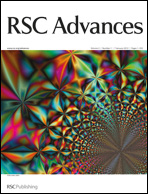Tunable photophysical properties, conformation and function of nanosized protein–gold constructs
Abstract
Protein-stabilized gold nanoconstructs are widely studied due to their potential applications in biosensing, drug and gene delivery, and bioimaging. While a number of studies have focused on the novel properties of such materials emanating from the gold, there has been little focus on how the protein shell is affected by nanocluster formation with respect to conformation, stability and function. Herein, we show the synthesis of protein-stabilized gold nanoconstructs varying in size from small clusters (~8 Au atoms) dispersed within proteins to nanoparticles stabilized by multiple proteins by varying the concentration of gold precursor and reducing agent. Proteins used were bovine serum albumin (BSA), bovine α-lactalbumin (BLA) and lysozyme (LYZ). Photophysical properties of the gold nanostructures were monitored using UV-vis and fluorescence measurements, revealing that the gold constructs can be tuned from luminescent clusters to nanoparticles displaying localized surface plasmon resonance (LSPR). Conformational changes of the protein following conjugation to gold nanostructures were studied using steady-state and time-resolved Trp fluorescence measurements and circular dichroism. The degree of conformational perturbation varied greatly between the proteins used, with BLA being the most tunable in terms of gradual unfolding, whereas the conformational stability of LYZ was very sensitive to the reducing agent used. To assess the impact of the gold nanostructures as well as the reducing agent on protein function, the LYZ–gold nanoconstructs were subjected to an activity test by degradation of Micrococcus lysodeikticus cell walls, revealing that the activity of the LYZ–Au constructs was retained and tunable, albeit at attenuated levels.


 Please wait while we load your content...
Please wait while we load your content...